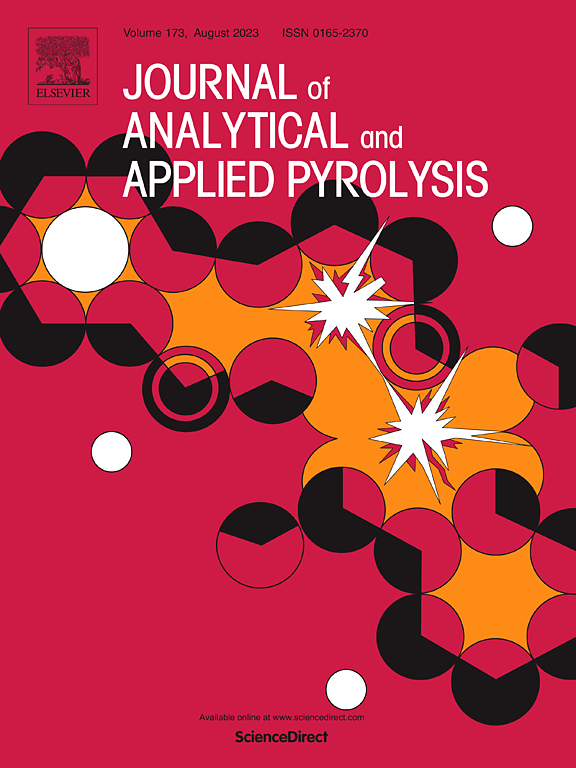Effect of hydrothermal conditions of temperature-pressure decoupling on the production characteristics of N/S-free biocrude from dry-rendered animal carcasses
IF 5.8
2区 化学
Q1 CHEMISTRY, ANALYTICAL
引用次数: 0
Abstract
To enhance the value of diseased and dead livestock resources, this study investigated the hydrothermal conversion of dry-rendered animal carcasses into N/S-free biocrude. Hydrothermal treatments were conducted under varying holding temperatures (HT), retention times (RT), and working pressures (WP) using temperature-pressure decoupling. The recovery, elemental composition, functional groups, and chemical composition of biocrude, and degradation characteristics of solid residue (SR), were analyzed. The results showed that all biocrudes were S-free and rich in hydrocarbons. At 200 °C, 15 min, and 10 MPa, the biocrude recovery reached nearly 100 % (100.76 %), and the aqueous phase (AP) yield was maximized, enabling efficient component separation. As RT increased, the optimal condition for producing N/S-free biocrude was identified (200 °C, 45 min, and 10 MPa), where the biocrude recovery exceeded 100 % (107.79 %), with an N content of only 0.15 % and a HHV of 38.14 MJ/kg, demonstrating its suitability for biofuel refinement, while the degradation of SR was more complete. WP significantly influenced the HHV, increasing it substantially from 32.06 to 38.14 MJ/kg as WP increased from self-generated pressure to 10 MPa. Furthermore, the conversion characteristics of N-free and N-containing compounds, along with the comprehensive reaction mechanism, were examined. This study provides a viable pathway for the efficient utilization of diseased and dead livestock resources and producing low-N or N-free biocrude from high-protein/high-fat biomass.
温度-压力解耦水热条件对干馏动物尸体生产无氮/ s生物原油特性的影响
为了提高病死牲畜资源的利用价值,本研究采用水热法将干燥动物尸体转化为不含氮/硫的生物原油。在不同保温温度(HT)、保温时间(RT)和工作压力(WP)下,采用温度-压力解耦法进行水热处理。分析了生物原油的回收率、元素组成、官能团、化学组成及固体残渣的降解特性。结果表明,所有生物原油均不含s,且富含碳氢化合物。在200 °C、15 min、10 MPa条件下,生物原油回收率接近100 %(100.76 %),水相收率达到最高,实现了组分的高效分离。随着温度的升高,确定了无氮/ s生物原油生产的最佳条件(200 °C, 45 min, 10 MPa),生物原油回收率超过100 %(107.79 %),N含量仅为0.15 %,HHV为38.14 MJ/kg,表明其适合生物燃料精制,而SR的降解更彻底。WP对HHV有显著影响,当WP从自产压力增加到10 MPa时,HHV从32.06大幅增加到38.14 MJ/kg。此外,还考察了无氮和含氮化合物的转化特性,以及综合反应机理。本研究为高效利用病死牲畜资源,利用高蛋白/高脂肪生物质生产低氮或无氮生物原油提供了一条可行途径。
本文章由计算机程序翻译,如有差异,请以英文原文为准。
求助全文
约1分钟内获得全文
求助全文
来源期刊
CiteScore
9.10
自引率
11.70%
发文量
340
审稿时长
44 days
期刊介绍:
The Journal of Analytical and Applied Pyrolysis (JAAP) is devoted to the publication of papers dealing with innovative applications of pyrolysis processes, the characterization of products related to pyrolysis reactions, and investigations of reaction mechanism. To be considered by JAAP, a manuscript should present significant progress in these topics. The novelty must be satisfactorily argued in the cover letter. A manuscript with a cover letter to the editor not addressing the novelty is likely to be rejected without review.

 求助内容:
求助内容: 应助结果提醒方式:
应助结果提醒方式:


